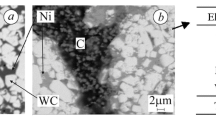Conclusions
The bend strength of VNS20 and VNS32 composites is determined by the quantity of η1phase and depends little upon the content of binder (PKhl8N15 steel). The hardness, on the other hand, depends substantially upon both the η1-phase content and upon the quantity of binder.
The VNS20 and VNS32 composites sintered at the temperatures of the start of formation of the liquid phase in the tungsten carbide—PKhl8N15 steel system, when compaction is completed and the rate of formation of η1-phase is still insignificant, have the optimum properties.
With a satisfactory level of physicomechanical properties, the VNS20 and VNS32 composites show high corrosion resistance in a medium of nitrine with additions of nitric acid.
An increase in the strength of VNS type composites may be obtained by reducing the diffusion reaction of tungsten carbide with stainless steel.
Similar content being viewed by others
Literature cited
V. B. Nesterenko, “Scientific and technical fundamentals of the development of atomic power stations with gas-cooled fast reactors using a dissociating heat carrier and pressing problems of new investigations,” in: Summaries of Papers for the 5th All-Union Conference on “Dissociating Gases as Heat Carriers and the Working Media of Atomic Power Stations” t in Russian], Inst. Yad. Énerg. Akad. Nauk Belorus. SSR, Minsk (1982), pp. 3–5.
V. P. Bondarenko, K. I. Sirota, and A. A. Orap, “An investigation of the influence of the composition of sintered materials based on VN group sintered carbides on the structure, physicomechanical properties, and life in a rubbing pair,” in: The Technology of Production of Sintered Carbide Parts [in Russian], Inst. Sverkhtverd. Mater. Akad. Nauk UkrSSR, Kiev (1980), pp. 84–90.
V. P. Bondarenko, A. P. Khalepa, K. I. Sirota, et al., “An investigation of the corrosion resistance of sintered carbides and composite materials with a nickel binder in nitric acid,” in: Materials of the 5th All-Union Conference on “Dissociating Gases as Heat Carriers and the Working Media of Atomic Power Stations [in Russian], Part 4, Inst. Yad. Énerg. Akad. Nauk Belorus. SSR, Minsk (1982), pp. 32–39.
V. P. Bondarenko, A. M. Baranovskii, A. P. Khalepa, et al., “An investigation of the corrosion resistance of sintered carbide-base composite materials in nitride,” ibid., pp. 40–45.
Zh. I. Dzneladze, R. P. Shchegoleva, L. S. Golubeva, et al., The Powder Metallurgy of Steels and Alloys [in Russian], Metallurgiya, Moscow (1978).
V. P. Kopylova, “The chemical resistance of the carbides of groups IV–VI transition elements,” Zh. Prikl. Khim.,34, No. 9, 1936–1939 (1961).
A. M. Sukhotin and V. S. Zotikov, The Chemical Resistance of Materials [in Russian], Khimiya, Leningrad (1975).
British Patent 1293610, “A sintered-steel-bonded carbide hard alloy,” published Oct. 18, 1972.
V. I. Tret'yakov, Fundamentals of the Metallurgy and Production Technology of Hard Alloys [in Russian], Metallurgiya, Moscow (1976).
V. P. Bondarenko, V. I. Tret'yakov, R. V. Rybal'chenko, et al. (eds.), Standard Methods of Inspection of the Raw Material of Semifinished Products, Finished Production, and Production Operations in the Production of Sintered Carbides [in Russian], Naukova Dumka, Kiev (1974).
T. Allen, Particle Size Measurements, New York (1981).
V. N. Svechnikov, Yu. A. Kocherzhinskii, A. K. Shurin, et al., “Apparatus for physicochemical investigation of refractory and chemically active metals,” in: Questions of Metal Physics and Metal Science [in Russian], Naukova Dumka, Kiev (1962), pp. 220–230.
N. D. Toraashov and G. P. Chernova, Passivity and Protection of Metals [in Russian], Nauka, Moscow (1965).
S. K. Senotrusov and V. Ya. Sych, “The influence of vacuum sintering on the refining of Khl8N15 steel,” Poroshk. Metall., No. 7, 21–25 (1980).
Author information
Authors and Affiliations
Additional information
Translated from Poroshkovaya Metallurgiya, No. 5(281), pp. 69–75, May, 1986.
Rights and permissions
About this article
Cite this article
Bondarenko, V.P., Ganopol'skii, A.Y. Development of tungsten-carbide-base corrosion-resistant composite materials with a binder of PKh8N15 stainless steel. Powder Metall Met Ceram 25, 415–419 (1986). https://doi.org/10.1007/BF00813958
Received:
Issue Date:
DOI: https://doi.org/10.1007/BF00813958




